Detailed Analysis: Server Technologies and Multipage Website Dev
VerifiedAdded on 2024/05/23
|34
|5479
|345
Report
AI Summary
This report provides a comprehensive overview of web development, starting with an explanation of server technologies and management services associated with hosting and managing websites, including the purpose and types of DNS. It explores the relationship between communication protocols, server hardware, operating systems, and web server software in designing, publishing, and accessing websites. The report categorizes website technologies, tools, and software used in development, discussing front-end and back-end capabilities and their relation to presentation and application layers. It also differentiates between online website creation tools and custom-built sites and outlines tools and techniques for custom-built sites. Furthermore, the report details the creation of a multipage website using good design principles and content, supported by a design document and branding. Finally, it covers the creation and use of a test plan to review website performance and design, identifying key performance areas and evaluating functionality and performance, providing a complete picture of the website development process.
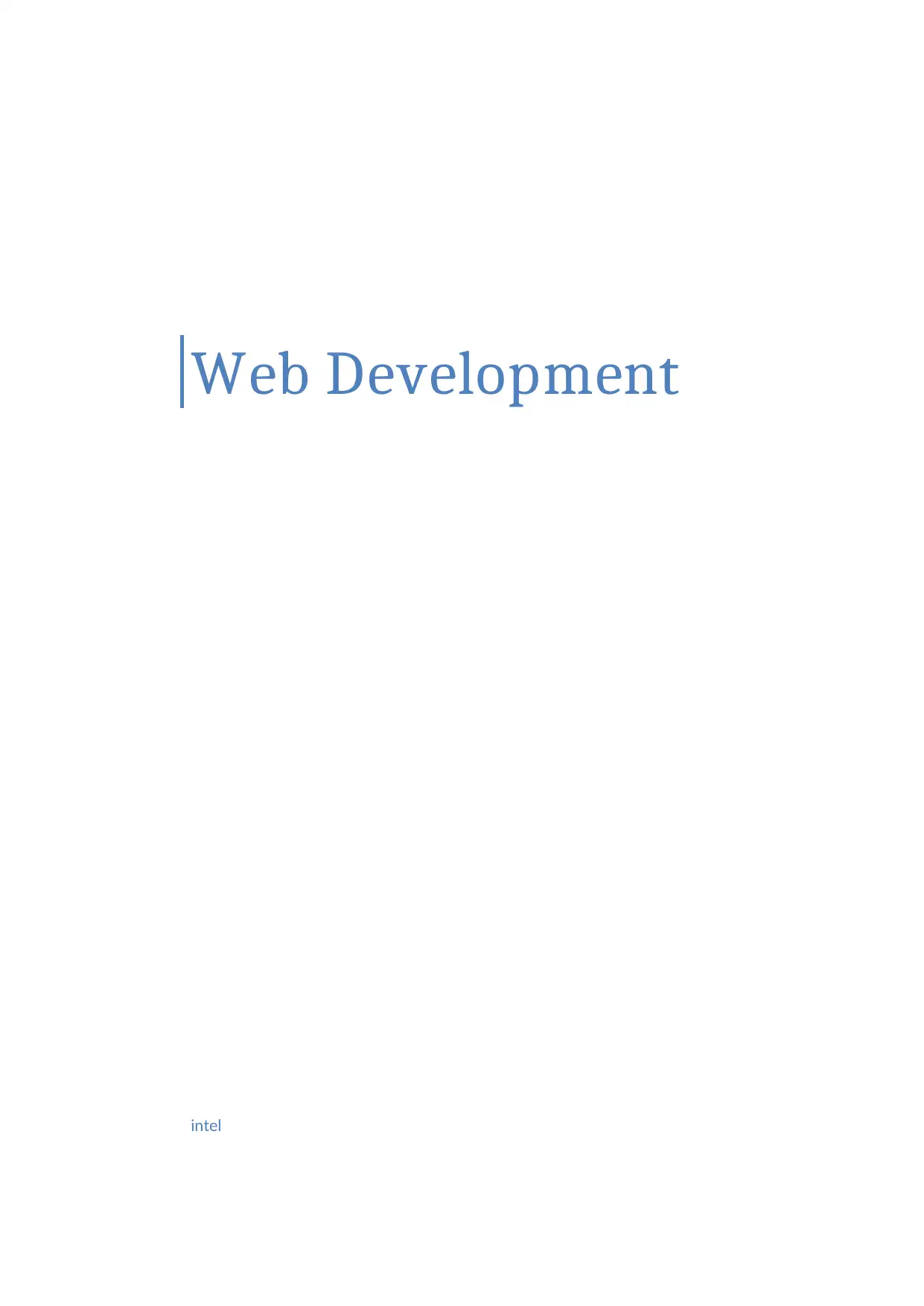
Web Development
intel
intel
Paraphrase This Document
Need a fresh take? Get an instant paraphrase of this document with our AI Paraphraser
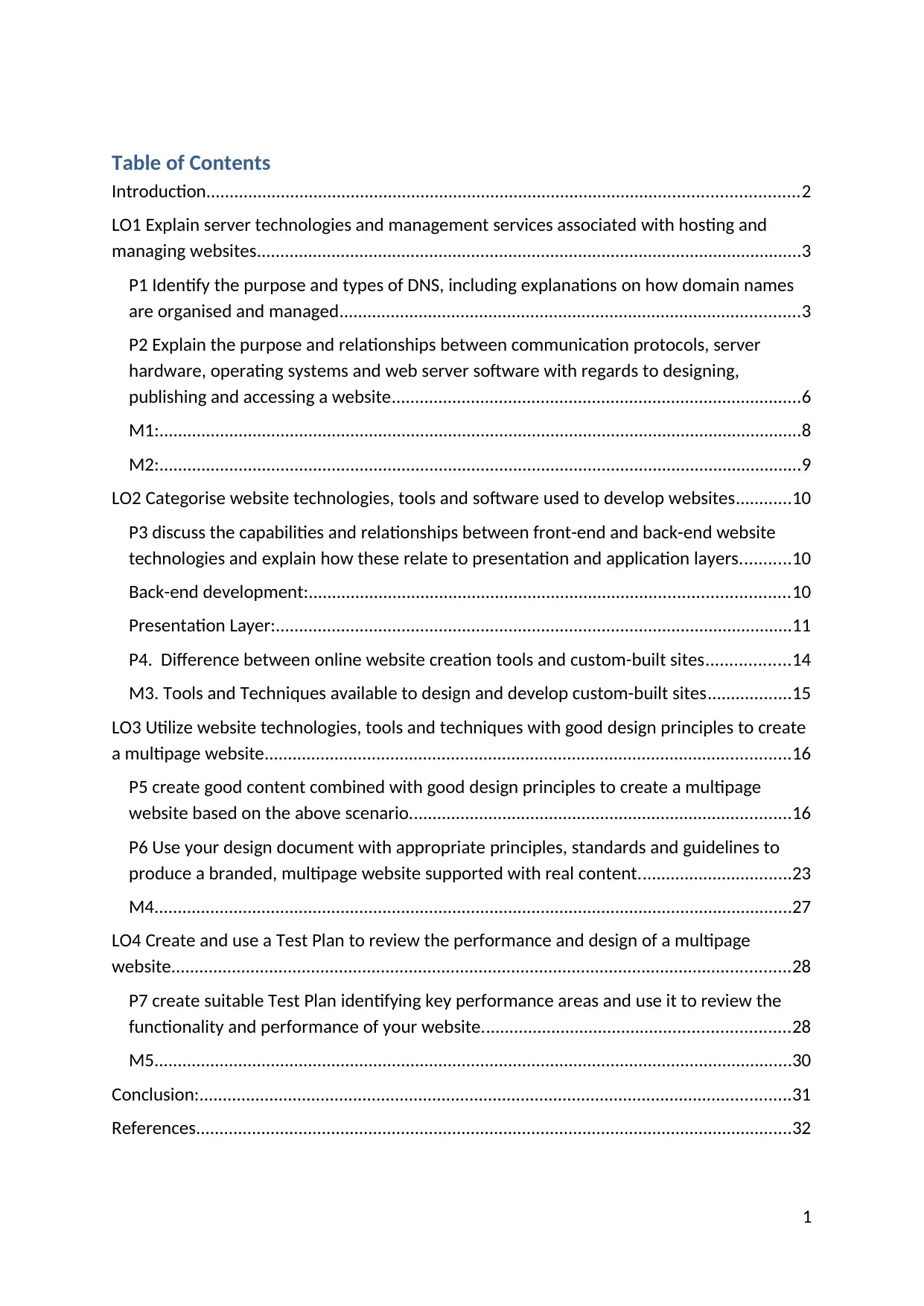
Table of Contents
Introduction...............................................................................................................................2
LO1 Explain server technologies and management services associated with hosting and
managing websites.....................................................................................................................3
P1 Identify the purpose and types of DNS, including explanations on how domain names
are organised and managed...................................................................................................3
P2 Explain the purpose and relationships between communication protocols, server
hardware, operating systems and web server software with regards to designing,
publishing and accessing a website........................................................................................6
M1:..........................................................................................................................................8
M2:..........................................................................................................................................9
LO2 Categorise website technologies, tools and software used to develop websites............10
P3 discuss the capabilities and relationships between front-end and back-end website
technologies and explain how these relate to presentation and application layers...........10
Back-end development:.......................................................................................................10
Presentation Layer:...............................................................................................................11
P4. Difference between online website creation tools and custom-built sites..................14
M3. Tools and Techniques available to design and develop custom-built sites..................15
LO3 Utilize website technologies, tools and techniques with good design principles to create
a multipage website.................................................................................................................16
P5 create good content combined with good design principles to create a multipage
website based on the above scenario..................................................................................16
P6 Use your design document with appropriate principles, standards and guidelines to
produce a branded, multipage website supported with real content.................................23
M4.........................................................................................................................................27
LO4 Create and use a Test Plan to review the performance and design of a multipage
website.....................................................................................................................................28
P7 create suitable Test Plan identifying key performance areas and use it to review the
functionality and performance of your website..................................................................28
M5.........................................................................................................................................30
Conclusion:...............................................................................................................................31
References................................................................................................................................32
1
Introduction...............................................................................................................................2
LO1 Explain server technologies and management services associated with hosting and
managing websites.....................................................................................................................3
P1 Identify the purpose and types of DNS, including explanations on how domain names
are organised and managed...................................................................................................3
P2 Explain the purpose and relationships between communication protocols, server
hardware, operating systems and web server software with regards to designing,
publishing and accessing a website........................................................................................6
M1:..........................................................................................................................................8
M2:..........................................................................................................................................9
LO2 Categorise website technologies, tools and software used to develop websites............10
P3 discuss the capabilities and relationships between front-end and back-end website
technologies and explain how these relate to presentation and application layers...........10
Back-end development:.......................................................................................................10
Presentation Layer:...............................................................................................................11
P4. Difference between online website creation tools and custom-built sites..................14
M3. Tools and Techniques available to design and develop custom-built sites..................15
LO3 Utilize website technologies, tools and techniques with good design principles to create
a multipage website.................................................................................................................16
P5 create good content combined with good design principles to create a multipage
website based on the above scenario..................................................................................16
P6 Use your design document with appropriate principles, standards and guidelines to
produce a branded, multipage website supported with real content.................................23
M4.........................................................................................................................................27
LO4 Create and use a Test Plan to review the performance and design of a multipage
website.....................................................................................................................................28
P7 create suitable Test Plan identifying key performance areas and use it to review the
functionality and performance of your website..................................................................28
M5.........................................................................................................................................30
Conclusion:...............................................................................................................................31
References................................................................................................................................32
1
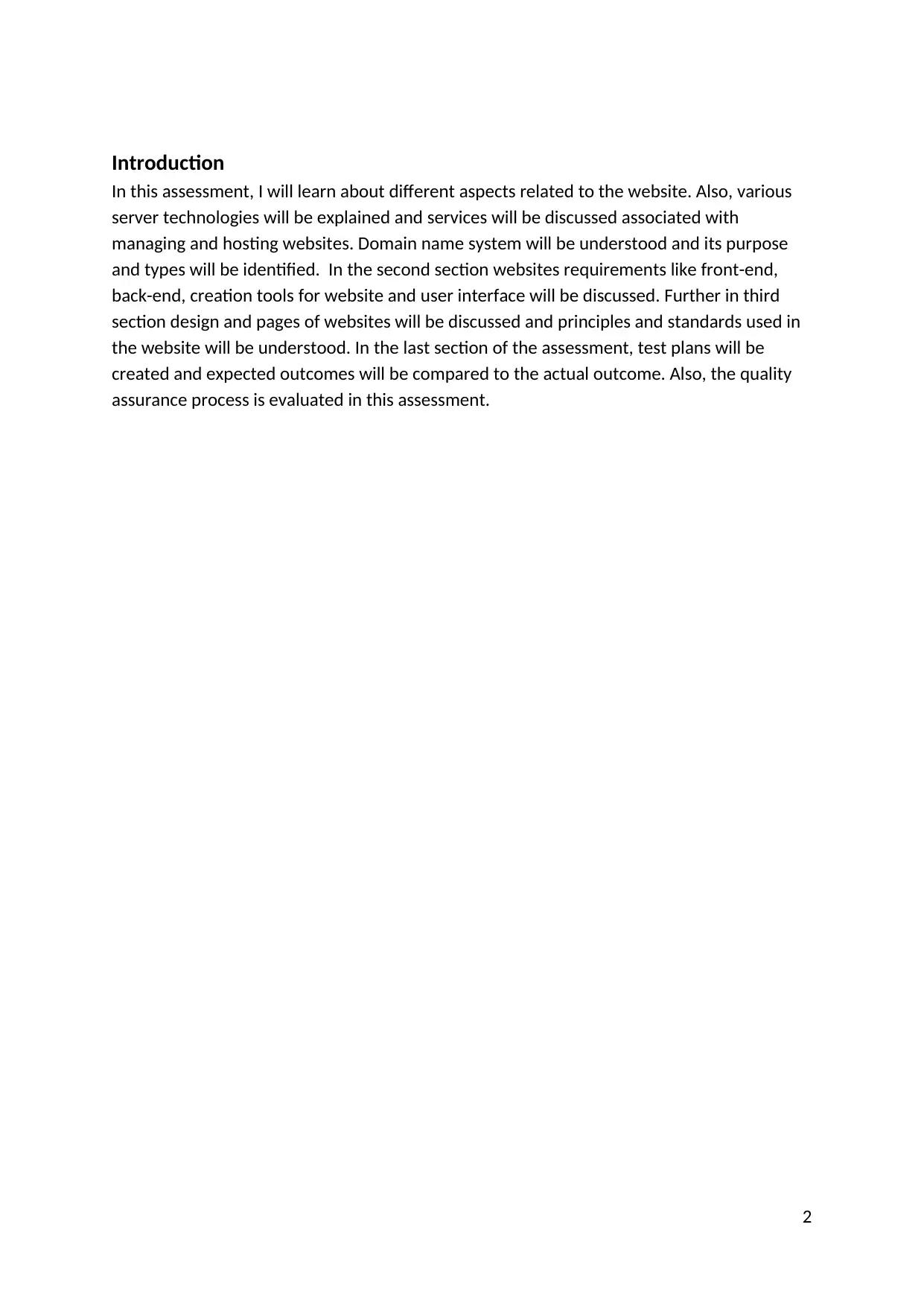
Introduction
In this assessment, I will learn about different aspects related to the website. Also, various
server technologies will be explained and services will be discussed associated with
managing and hosting websites. Domain name system will be understood and its purpose
and types will be identified. In the second section websites requirements like front-end,
back-end, creation tools for website and user interface will be discussed. Further in third
section design and pages of websites will be discussed and principles and standards used in
the website will be understood. In the last section of the assessment, test plans will be
created and expected outcomes will be compared to the actual outcome. Also, the quality
assurance process is evaluated in this assessment.
2
In this assessment, I will learn about different aspects related to the website. Also, various
server technologies will be explained and services will be discussed associated with
managing and hosting websites. Domain name system will be understood and its purpose
and types will be identified. In the second section websites requirements like front-end,
back-end, creation tools for website and user interface will be discussed. Further in third
section design and pages of websites will be discussed and principles and standards used in
the website will be understood. In the last section of the assessment, test plans will be
created and expected outcomes will be compared to the actual outcome. Also, the quality
assurance process is evaluated in this assessment.
2
⊘ This is a preview!⊘
Do you want full access?
Subscribe today to unlock all pages.

Trusted by 1+ million students worldwide
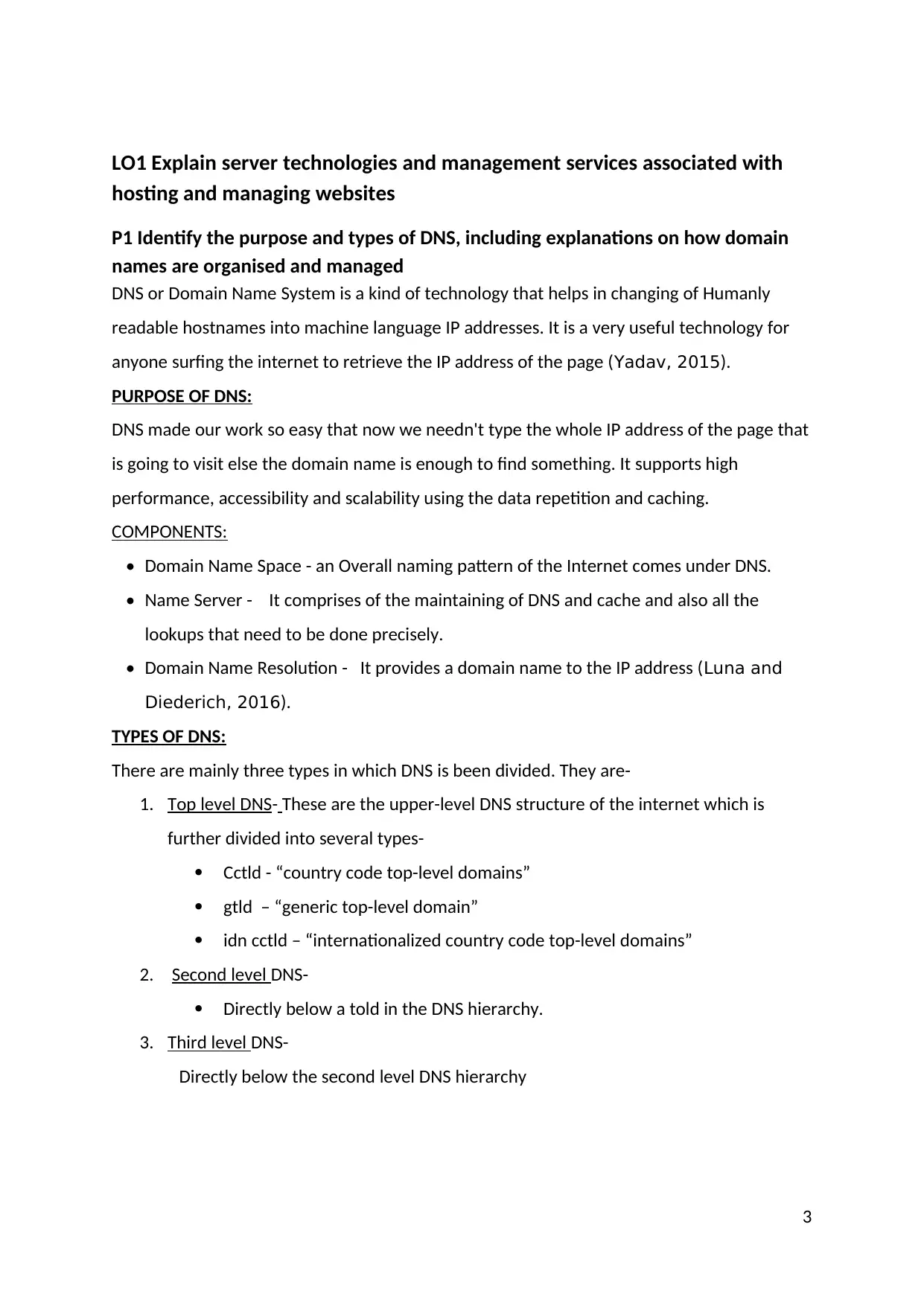
LO1 Explain server technologies and management services associated with
hosting and managing websites
P1 Identify the purpose and types of DNS, including explanations on how domain
names are organised and managed
DNS or Domain Name System is a kind of technology that helps in changing of Humanly
readable hostnames into machine language IP addresses. It is a very useful technology for
anyone surfing the internet to retrieve the IP address of the page (Yadav, 2015).
PURPOSE OF DNS:
DNS made our work so easy that now we needn't type the whole IP address of the page that
is going to visit else the domain name is enough to find something. It supports high
performance, accessibility and scalability using the data repetition and caching.
COMPONENTS:
• Domain Name Space - an Overall naming pattern of the Internet comes under DNS.
• Name Server - It comprises of the maintaining of DNS and cache and also all the
lookups that need to be done precisely.
• Domain Name Resolution - It provides a domain name to the IP address (Luna and
Diederich, 2016).
TYPES OF DNS:
There are mainly three types in which DNS is been divided. They are-
1. Top level DNS- These are the upper-level DNS structure of the internet which is
further divided into several types-
Cctld - “country code top-level domains”
gtld – “generic top-level domain”
idn cctld – “internationalized country code top-level domains”
2. Second level DNS-
Directly below a told in the DNS hierarchy.
3. Third level DNS-
Directly below the second level DNS hierarchy
3
hosting and managing websites
P1 Identify the purpose and types of DNS, including explanations on how domain
names are organised and managed
DNS or Domain Name System is a kind of technology that helps in changing of Humanly
readable hostnames into machine language IP addresses. It is a very useful technology for
anyone surfing the internet to retrieve the IP address of the page (Yadav, 2015).
PURPOSE OF DNS:
DNS made our work so easy that now we needn't type the whole IP address of the page that
is going to visit else the domain name is enough to find something. It supports high
performance, accessibility and scalability using the data repetition and caching.
COMPONENTS:
• Domain Name Space - an Overall naming pattern of the Internet comes under DNS.
• Name Server - It comprises of the maintaining of DNS and cache and also all the
lookups that need to be done precisely.
• Domain Name Resolution - It provides a domain name to the IP address (Luna and
Diederich, 2016).
TYPES OF DNS:
There are mainly three types in which DNS is been divided. They are-
1. Top level DNS- These are the upper-level DNS structure of the internet which is
further divided into several types-
Cctld - “country code top-level domains”
gtld – “generic top-level domain”
idn cctld – “internationalized country code top-level domains”
2. Second level DNS-
Directly below a told in the DNS hierarchy.
3. Third level DNS-
Directly below the second level DNS hierarchy
3
Paraphrase This Document
Need a fresh take? Get an instant paraphrase of this document with our AI Paraphraser
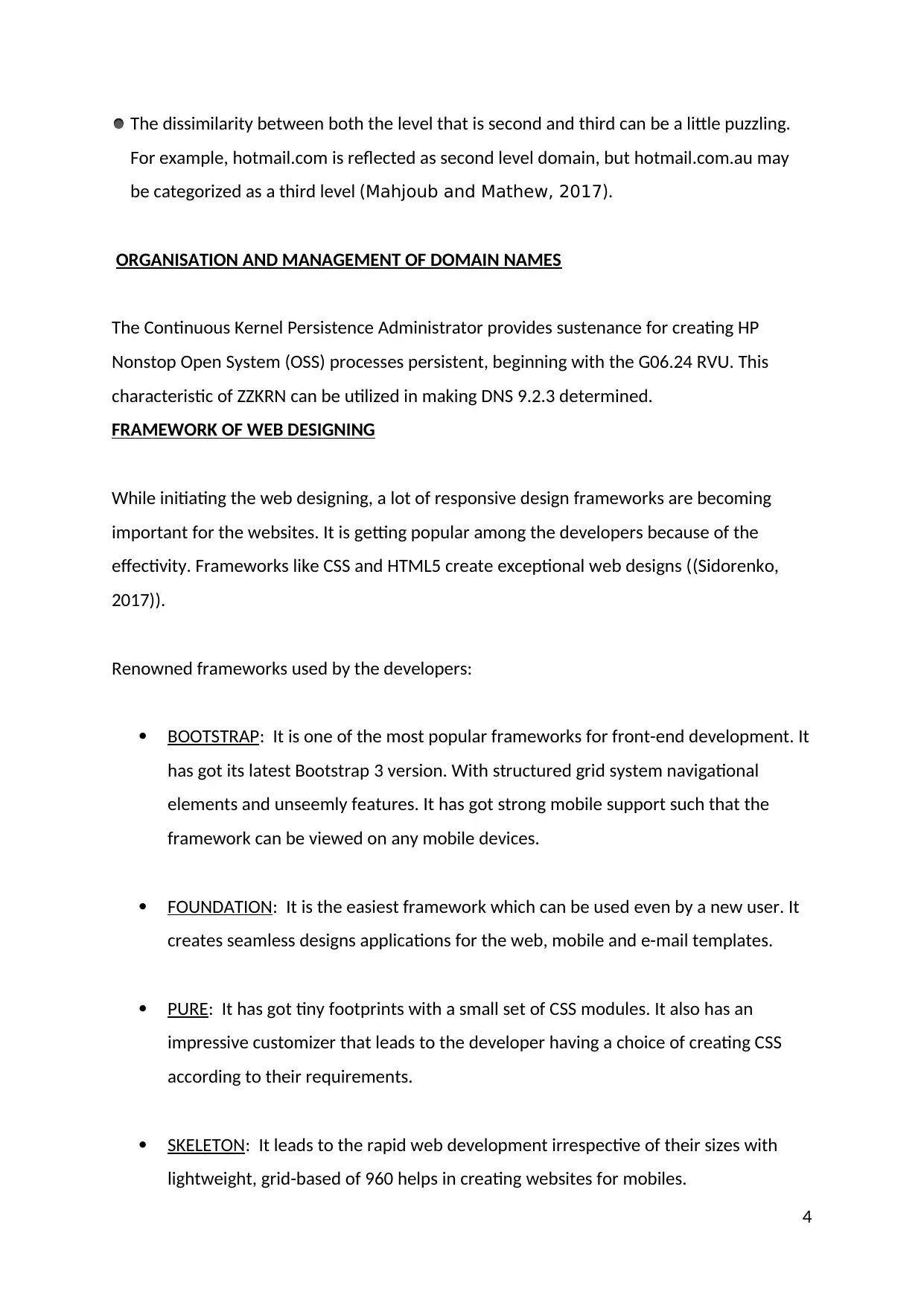
The dissimilarity between both the level that is second and third can be a little puzzling.
For example, hotmail.com is reflected as second level domain, but hotmail.com.au may
be categorized as a third level (Mahjoub and Mathew, 2017).
ORGANISATION AND MANAGEMENT OF DOMAIN NAMES
The Continuous Kernel Persistence Administrator provides sustenance for creating HP
Nonstop Open System (OSS) processes persistent, beginning with the G06.24 RVU. This
characteristic of ZZKRN can be utilized in making DNS 9.2.3 determined.
FRAMEWORK OF WEB DESIGNING
While initiating the web designing, a lot of responsive design frameworks are becoming
important for the websites. It is getting popular among the developers because of the
effectivity. Frameworks like CSS and HTML5 create exceptional web designs ((Sidorenko,
2017)).
Renowned frameworks used by the developers:
BOOTSTRAP: It is one of the most popular frameworks for front-end development. It
has got its latest Bootstrap 3 version. With structured grid system navigational
elements and unseemly features. It has got strong mobile support such that the
framework can be viewed on any mobile devices.
FOUNDATION: It is the easiest framework which can be used even by a new user. It
creates seamless designs applications for the web, mobile and e-mail templates.
PURE: It has got tiny footprints with a small set of CSS modules. It also has an
impressive customizer that leads to the developer having a choice of creating CSS
according to their requirements.
SKELETON: It leads to the rapid web development irrespective of their sizes with
lightweight, grid-based of 960 helps in creating websites for mobiles.
4
For example, hotmail.com is reflected as second level domain, but hotmail.com.au may
be categorized as a third level (Mahjoub and Mathew, 2017).
ORGANISATION AND MANAGEMENT OF DOMAIN NAMES
The Continuous Kernel Persistence Administrator provides sustenance for creating HP
Nonstop Open System (OSS) processes persistent, beginning with the G06.24 RVU. This
characteristic of ZZKRN can be utilized in making DNS 9.2.3 determined.
FRAMEWORK OF WEB DESIGNING
While initiating the web designing, a lot of responsive design frameworks are becoming
important for the websites. It is getting popular among the developers because of the
effectivity. Frameworks like CSS and HTML5 create exceptional web designs ((Sidorenko,
2017)).
Renowned frameworks used by the developers:
BOOTSTRAP: It is one of the most popular frameworks for front-end development. It
has got its latest Bootstrap 3 version. With structured grid system navigational
elements and unseemly features. It has got strong mobile support such that the
framework can be viewed on any mobile devices.
FOUNDATION: It is the easiest framework which can be used even by a new user. It
creates seamless designs applications for the web, mobile and e-mail templates.
PURE: It has got tiny footprints with a small set of CSS modules. It also has an
impressive customizer that leads to the developer having a choice of creating CSS
according to their requirements.
SKELETON: It leads to the rapid web development irrespective of their sizes with
lightweight, grid-based of 960 helps in creating websites for mobiles.
4
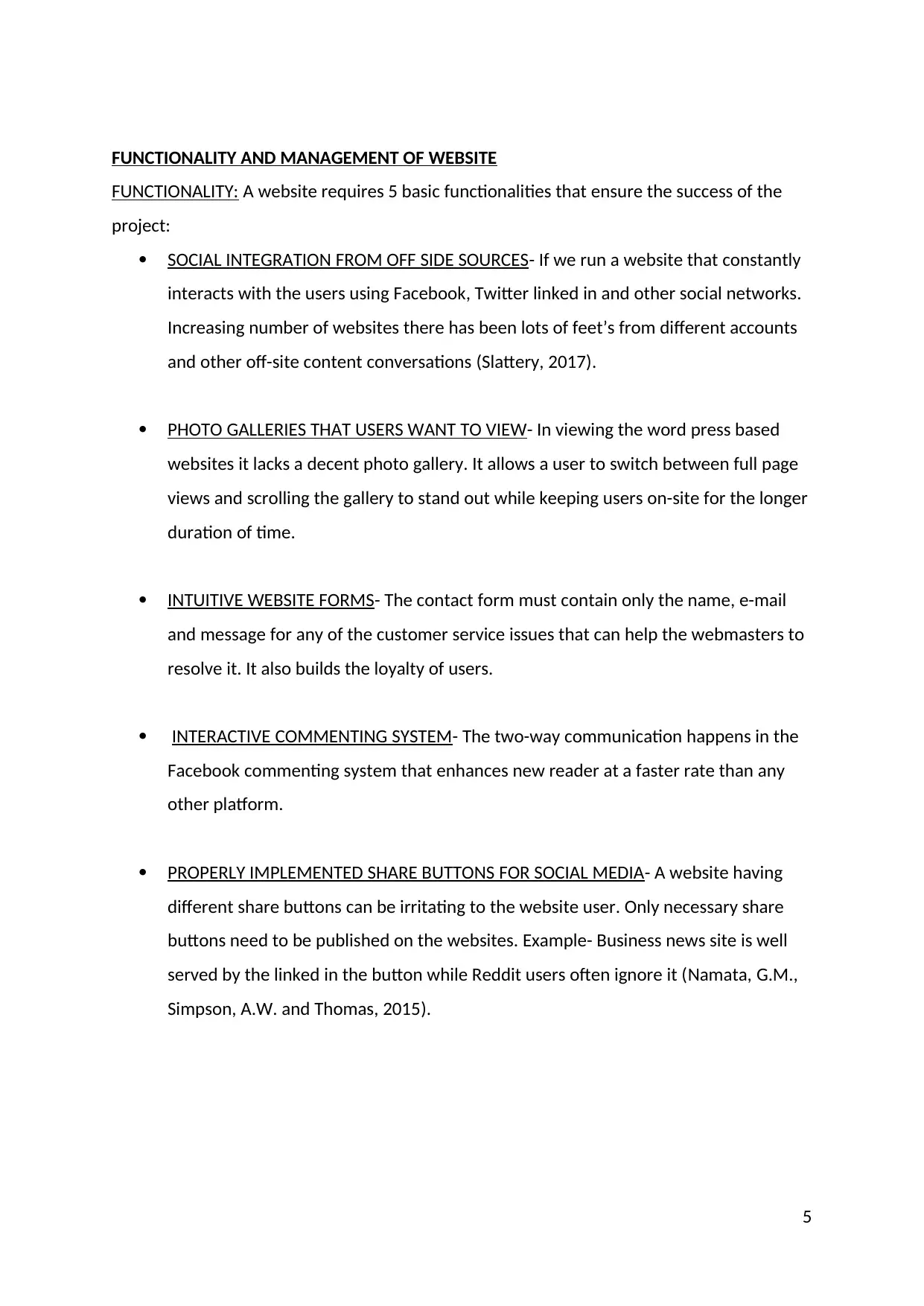
FUNCTIONALITY AND MANAGEMENT OF WEBSITE
FUNCTIONALITY: A website requires 5 basic functionalities that ensure the success of the
project:
SOCIAL INTEGRATION FROM OFF SIDE SOURCES- If we run a website that constantly
interacts with the users using Facebook, Twitter linked in and other social networks.
Increasing number of websites there has been lots of feet’s from different accounts
and other off-site content conversations (Slattery, 2017).
PHOTO GALLERIES THAT USERS WANT TO VIEW- In viewing the word press based
websites it lacks a decent photo gallery. It allows a user to switch between full page
views and scrolling the gallery to stand out while keeping users on-site for the longer
duration of time.
INTUITIVE WEBSITE FORMS- The contact form must contain only the name, e-mail
and message for any of the customer service issues that can help the webmasters to
resolve it. It also builds the loyalty of users.
INTERACTIVE COMMENTING SYSTEM- The two-way communication happens in the
Facebook commenting system that enhances new reader at a faster rate than any
other platform.
PROPERLY IMPLEMENTED SHARE BUTTONS FOR SOCIAL MEDIA- A website having
different share buttons can be irritating to the website user. Only necessary share
buttons need to be published on the websites. Example- Business news site is well
served by the linked in the button while Reddit users often ignore it (Namata, G.M.,
Simpson, A.W. and Thomas, 2015).
5
FUNCTIONALITY: A website requires 5 basic functionalities that ensure the success of the
project:
SOCIAL INTEGRATION FROM OFF SIDE SOURCES- If we run a website that constantly
interacts with the users using Facebook, Twitter linked in and other social networks.
Increasing number of websites there has been lots of feet’s from different accounts
and other off-site content conversations (Slattery, 2017).
PHOTO GALLERIES THAT USERS WANT TO VIEW- In viewing the word press based
websites it lacks a decent photo gallery. It allows a user to switch between full page
views and scrolling the gallery to stand out while keeping users on-site for the longer
duration of time.
INTUITIVE WEBSITE FORMS- The contact form must contain only the name, e-mail
and message for any of the customer service issues that can help the webmasters to
resolve it. It also builds the loyalty of users.
INTERACTIVE COMMENTING SYSTEM- The two-way communication happens in the
Facebook commenting system that enhances new reader at a faster rate than any
other platform.
PROPERLY IMPLEMENTED SHARE BUTTONS FOR SOCIAL MEDIA- A website having
different share buttons can be irritating to the website user. Only necessary share
buttons need to be published on the websites. Example- Business news site is well
served by the linked in the button while Reddit users often ignore it (Namata, G.M.,
Simpson, A.W. and Thomas, 2015).
5
⊘ This is a preview!⊘
Do you want full access?
Subscribe today to unlock all pages.

Trusted by 1+ million students worldwide
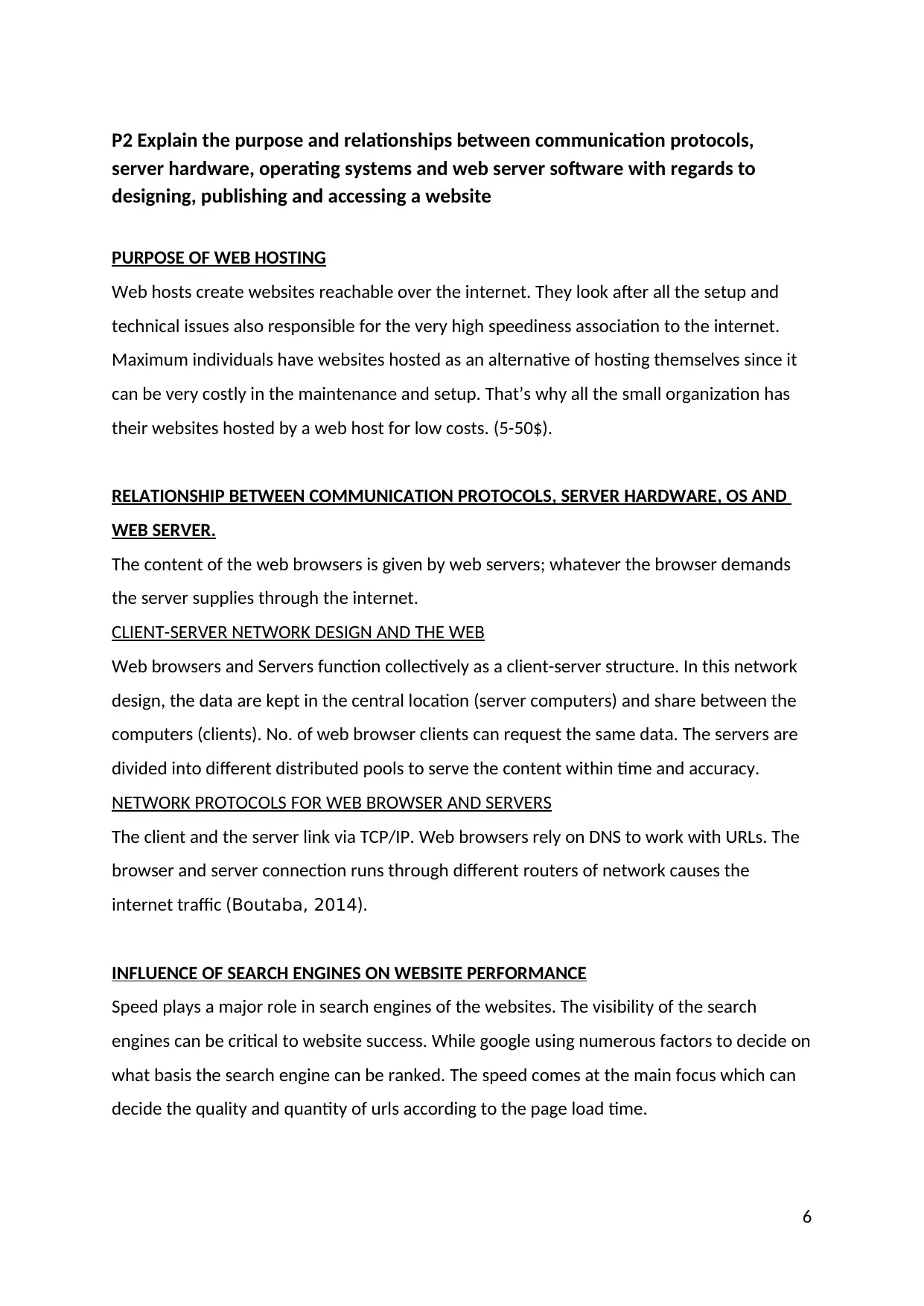
P2 Explain the purpose and relationships between communication protocols,
server hardware, operating systems and web server software with regards to
designing, publishing and accessing a website
PURPOSE OF WEB HOSTING
Web hosts create websites reachable over the internet. They look after all the setup and
technical issues also responsible for the very high speediness association to the internet.
Maximum individuals have websites hosted as an alternative of hosting themselves since it
can be very costly in the maintenance and setup. That’s why all the small organization has
their websites hosted by a web host for low costs. (5-50$).
RELATIONSHIP BETWEEN COMMUNICATION PROTOCOLS, SERVER HARDWARE, OS AND
WEB SERVER.
The content of the web browsers is given by web servers; whatever the browser demands
the server supplies through the internet.
CLIENT-SERVER NETWORK DESIGN AND THE WEB
Web browsers and Servers function collectively as a client-server structure. In this network
design, the data are kept in the central location (server computers) and share between the
computers (clients). No. of web browser clients can request the same data. The servers are
divided into different distributed pools to serve the content within time and accuracy.
NETWORK PROTOCOLS FOR WEB BROWSER AND SERVERS
The client and the server link via TCP/IP. Web browsers rely on DNS to work with URLs. The
browser and server connection runs through different routers of network causes the
internet traffic (Boutaba, 2014).
INFLUENCE OF SEARCH ENGINES ON WEBSITE PERFORMANCE
Speed plays a major role in search engines of the websites. The visibility of the search
engines can be critical to website success. While google using numerous factors to decide on
what basis the search engine can be ranked. The speed comes at the main focus which can
decide the quality and quantity of urls according to the page load time.
6
server hardware, operating systems and web server software with regards to
designing, publishing and accessing a website
PURPOSE OF WEB HOSTING
Web hosts create websites reachable over the internet. They look after all the setup and
technical issues also responsible for the very high speediness association to the internet.
Maximum individuals have websites hosted as an alternative of hosting themselves since it
can be very costly in the maintenance and setup. That’s why all the small organization has
their websites hosted by a web host for low costs. (5-50$).
RELATIONSHIP BETWEEN COMMUNICATION PROTOCOLS, SERVER HARDWARE, OS AND
WEB SERVER.
The content of the web browsers is given by web servers; whatever the browser demands
the server supplies through the internet.
CLIENT-SERVER NETWORK DESIGN AND THE WEB
Web browsers and Servers function collectively as a client-server structure. In this network
design, the data are kept in the central location (server computers) and share between the
computers (clients). No. of web browser clients can request the same data. The servers are
divided into different distributed pools to serve the content within time and accuracy.
NETWORK PROTOCOLS FOR WEB BROWSER AND SERVERS
The client and the server link via TCP/IP. Web browsers rely on DNS to work with URLs. The
browser and server connection runs through different routers of network causes the
internet traffic (Boutaba, 2014).
INFLUENCE OF SEARCH ENGINES ON WEBSITE PERFORMANCE
Speed plays a major role in search engines of the websites. The visibility of the search
engines can be critical to website success. While google using numerous factors to decide on
what basis the search engine can be ranked. The speed comes at the main focus which can
decide the quality and quantity of urls according to the page load time.
6
Paraphrase This Document
Need a fresh take? Get an instant paraphrase of this document with our AI Paraphraser
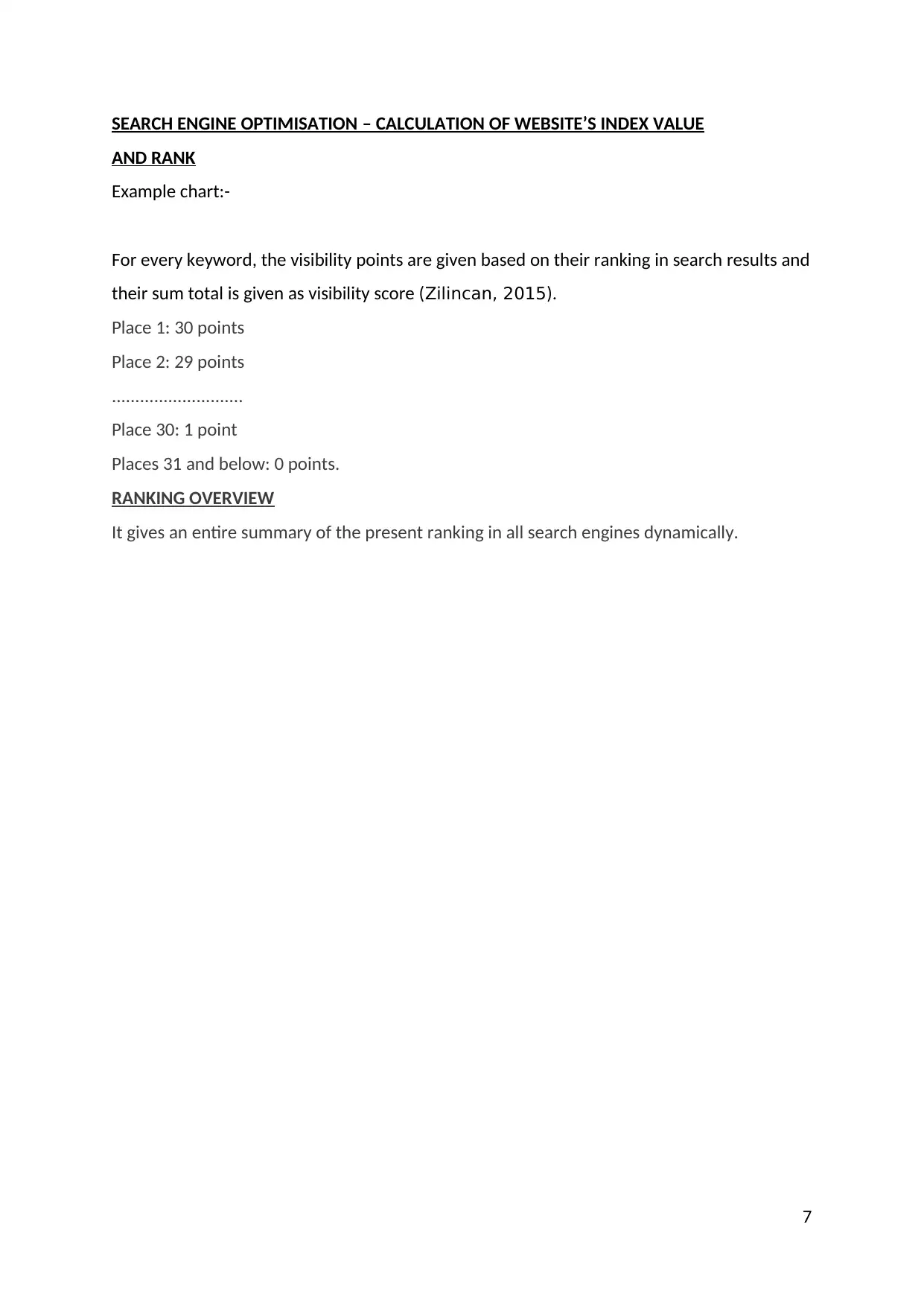
SEARCH ENGINE OPTIMISATION – CALCULATION OF WEBSITE’S INDEX VALUE
AND RANK
Example chart:-
For every keyword, the visibility points are given based on their ranking in search results and
their sum total is given as visibility score (Zilincan, 2015).
Place 1: 30 points
Place 2: 29 points
............................
Place 30: 1 point
Places 31 and below: 0 points.
RANKING OVERVIEW
It gives an entire summary of the present ranking in all search engines dynamically.
7
AND RANK
Example chart:-
For every keyword, the visibility points are given based on their ranking in search results and
their sum total is given as visibility score (Zilincan, 2015).
Place 1: 30 points
Place 2: 29 points
............................
Place 30: 1 point
Places 31 and below: 0 points.
RANKING OVERVIEW
It gives an entire summary of the present ranking in all search engines dynamically.
7
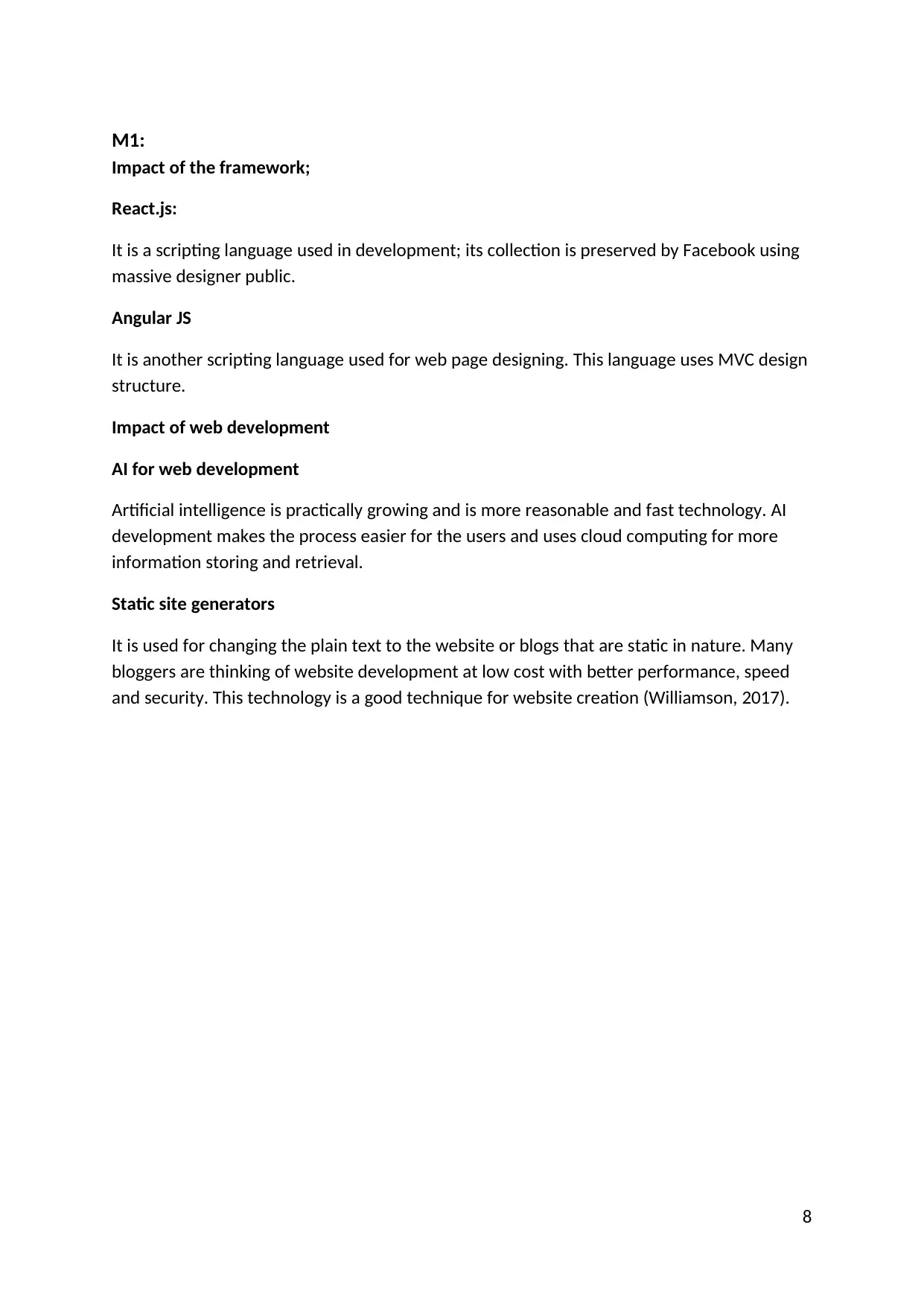
M1:
Impact of the framework;
React.js:
It is a scripting language used in development; its collection is preserved by Facebook using
massive designer public.
Angular JS
It is another scripting language used for web page designing. This language uses MVC design
structure.
Impact of web development
AI for web development
Artificial intelligence is practically growing and is more reasonable and fast technology. AI
development makes the process easier for the users and uses cloud computing for more
information storing and retrieval.
Static site generators
It is used for changing the plain text to the website or blogs that are static in nature. Many
bloggers are thinking of website development at low cost with better performance, speed
and security. This technology is a good technique for website creation (Williamson, 2017).
8
Impact of the framework;
React.js:
It is a scripting language used in development; its collection is preserved by Facebook using
massive designer public.
Angular JS
It is another scripting language used for web page designing. This language uses MVC design
structure.
Impact of web development
AI for web development
Artificial intelligence is practically growing and is more reasonable and fast technology. AI
development makes the process easier for the users and uses cloud computing for more
information storing and retrieval.
Static site generators
It is used for changing the plain text to the website or blogs that are static in nature. Many
bloggers are thinking of website development at low cost with better performance, speed
and security. This technology is a good technique for website creation (Williamson, 2017).
8
⊘ This is a preview!⊘
Do you want full access?
Subscribe today to unlock all pages.

Trusted by 1+ million students worldwide

M2:
Website position in result page of a search engine is denoted by the search engine
optimization ranking there are numerous impacts that affect the position of a website in
SERP. Bulks to ranking factor are given by the SEO. In SEO Ranking factor is an important
aspect. Using ranking factors total companion can be increased for the online portal by
obtaining the high rank that is to find the website on top of web search results. Backlinking
can be used for increasing the rank of the website and reach of the user (Korol, Slesarev,
and Nechai, 2014).
9
Website position in result page of a search engine is denoted by the search engine
optimization ranking there are numerous impacts that affect the position of a website in
SERP. Bulks to ranking factor are given by the SEO. In SEO Ranking factor is an important
aspect. Using ranking factors total companion can be increased for the online portal by
obtaining the high rank that is to find the website on top of web search results. Backlinking
can be used for increasing the rank of the website and reach of the user (Korol, Slesarev,
and Nechai, 2014).
9
Paraphrase This Document
Need a fresh take? Get an instant paraphrase of this document with our AI Paraphraser
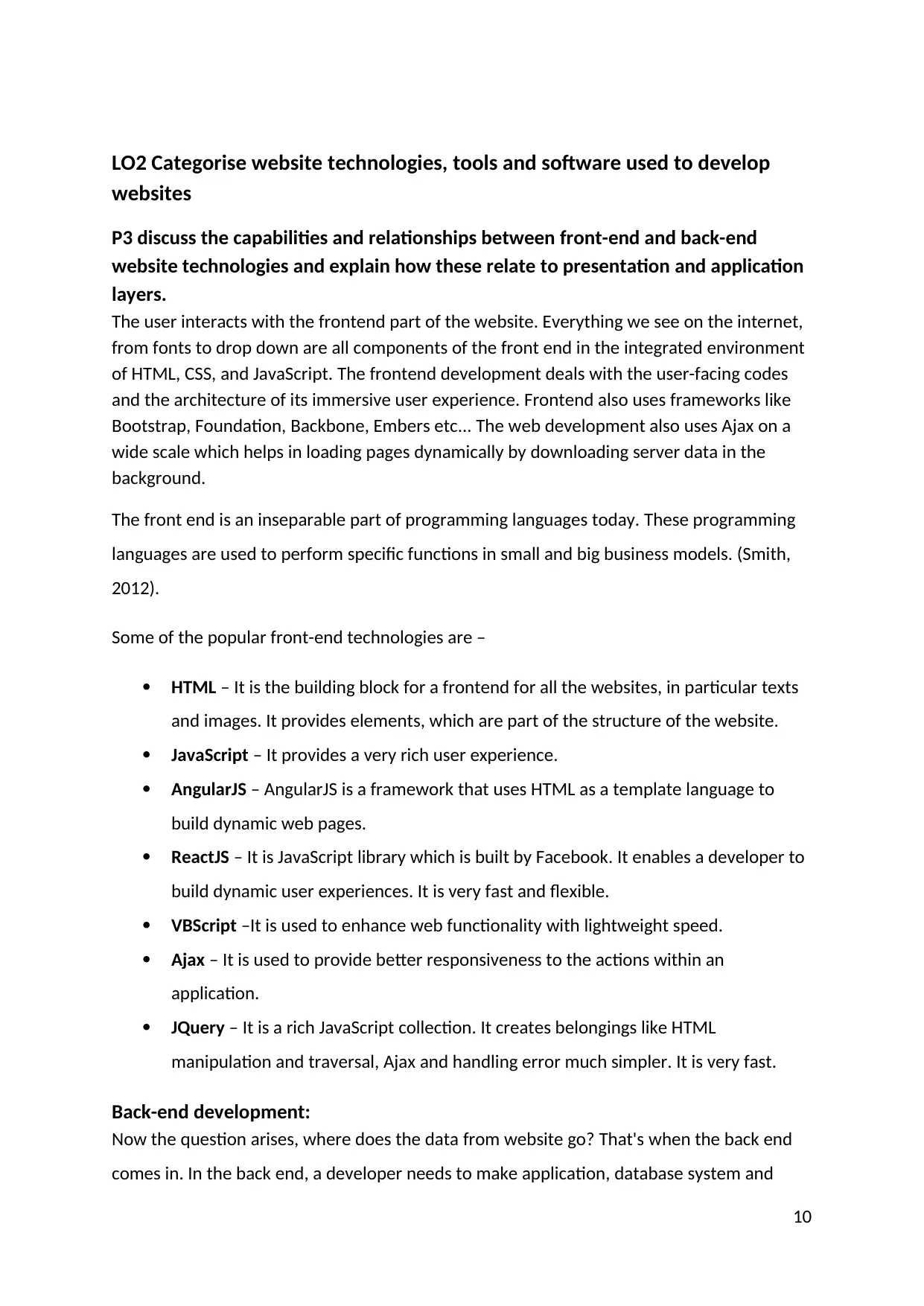
LO2 Categorise website technologies, tools and software used to develop
websites
P3 discuss the capabilities and relationships between front-end and back-end
website technologies and explain how these relate to presentation and application
layers.
The user interacts with the frontend part of the website. Everything we see on the internet,
from fonts to drop down are all components of the front end in the integrated environment
of HTML, CSS, and JavaScript. The frontend development deals with the user-facing codes
and the architecture of its immersive user experience. Frontend also uses frameworks like
Bootstrap, Foundation, Backbone, Embers etc... The web development also uses Ajax on a
wide scale which helps in loading pages dynamically by downloading server data in the
background.
The front end is an inseparable part of programming languages today. These programming
languages are used to perform specific functions in small and big business models. (Smith,
2012).
Some of the popular front-end technologies are –
HTML – It is the building block for a frontend for all the websites, in particular texts
and images. It provides elements, which are part of the structure of the website.
JavaScript – It provides a very rich user experience.
AngularJS – AngularJS is a framework that uses HTML as a template language to
build dynamic web pages.
ReactJS – It is JavaScript library which is built by Facebook. It enables a developer to
build dynamic user experiences. It is very fast and flexible.
VBScript –It is used to enhance web functionality with lightweight speed.
Ajax – It is used to provide better responsiveness to the actions within an
application.
JQuery – It is a rich JavaScript collection. It creates belongings like HTML
manipulation and traversal, Ajax and handling error much simpler. It is very fast.
Back-end development:
Now the question arises, where does the data from website go? That's when the back end
comes in. In the back end, a developer needs to make application, database system and
10
websites
P3 discuss the capabilities and relationships between front-end and back-end
website technologies and explain how these relate to presentation and application
layers.
The user interacts with the frontend part of the website. Everything we see on the internet,
from fonts to drop down are all components of the front end in the integrated environment
of HTML, CSS, and JavaScript. The frontend development deals with the user-facing codes
and the architecture of its immersive user experience. Frontend also uses frameworks like
Bootstrap, Foundation, Backbone, Embers etc... The web development also uses Ajax on a
wide scale which helps in loading pages dynamically by downloading server data in the
background.
The front end is an inseparable part of programming languages today. These programming
languages are used to perform specific functions in small and big business models. (Smith,
2012).
Some of the popular front-end technologies are –
HTML – It is the building block for a frontend for all the websites, in particular texts
and images. It provides elements, which are part of the structure of the website.
JavaScript – It provides a very rich user experience.
AngularJS – AngularJS is a framework that uses HTML as a template language to
build dynamic web pages.
ReactJS – It is JavaScript library which is built by Facebook. It enables a developer to
build dynamic user experiences. It is very fast and flexible.
VBScript –It is used to enhance web functionality with lightweight speed.
Ajax – It is used to provide better responsiveness to the actions within an
application.
JQuery – It is a rich JavaScript collection. It creates belongings like HTML
manipulation and traversal, Ajax and handling error much simpler. It is very fast.
Back-end development:
Now the question arises, where does the data from website go? That's when the back end
comes in. In the back end, a developer needs to make application, database system and
10
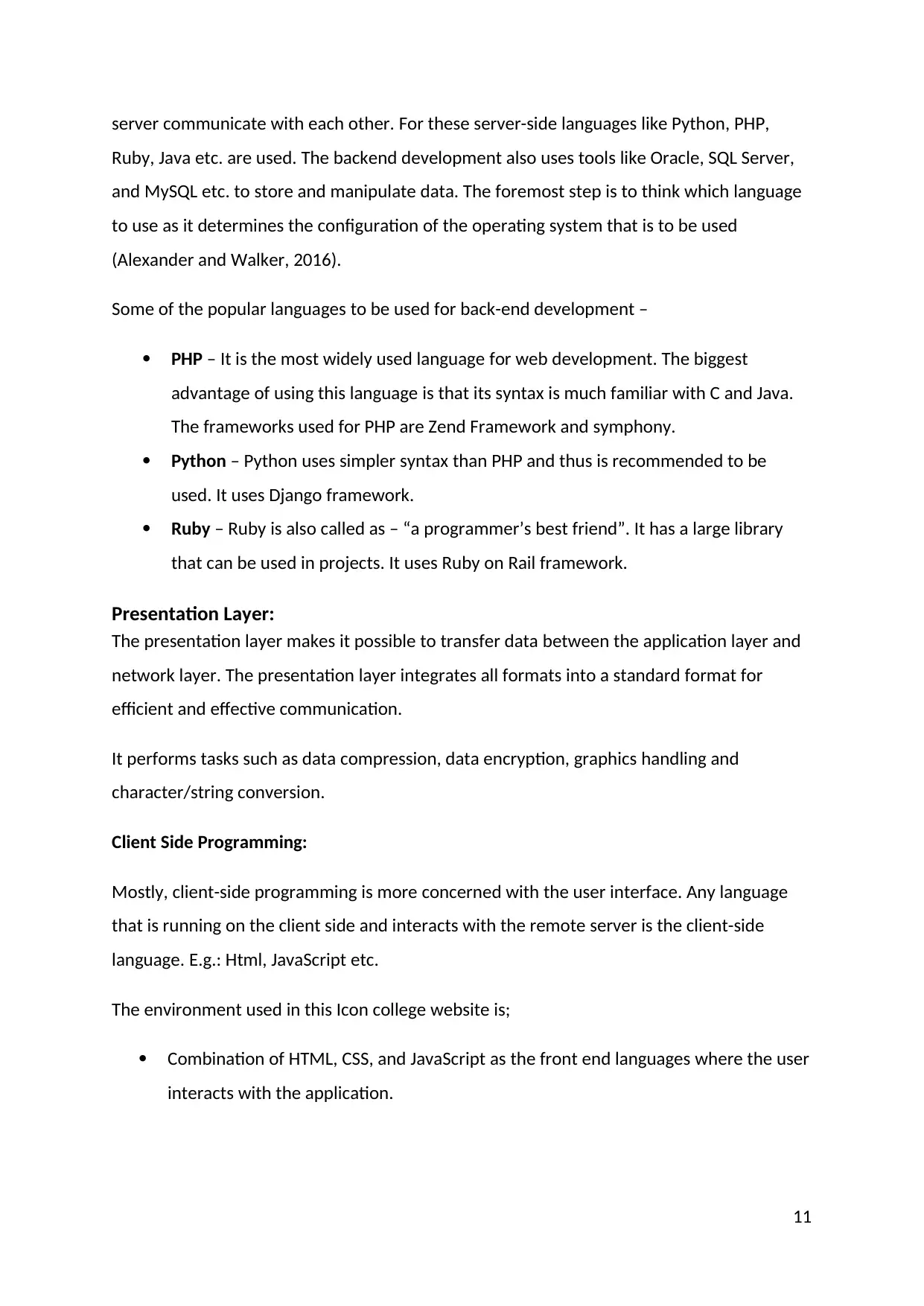
server communicate with each other. For these server-side languages like Python, PHP,
Ruby, Java etc. are used. The backend development also uses tools like Oracle, SQL Server,
and MySQL etc. to store and manipulate data. The foremost step is to think which language
to use as it determines the configuration of the operating system that is to be used
(Alexander and Walker, 2016).
Some of the popular languages to be used for back-end development –
PHP – It is the most widely used language for web development. The biggest
advantage of using this language is that its syntax is much familiar with C and Java.
The frameworks used for PHP are Zend Framework and symphony.
Python – Python uses simpler syntax than PHP and thus is recommended to be
used. It uses Django framework.
Ruby – Ruby is also called as – “a programmer’s best friend”. It has a large library
that can be used in projects. It uses Ruby on Rail framework.
Presentation Layer:
The presentation layer makes it possible to transfer data between the application layer and
network layer. The presentation layer integrates all formats into a standard format for
efficient and effective communication.
It performs tasks such as data compression, data encryption, graphics handling and
character/string conversion.
Client Side Programming:
Mostly, client-side programming is more concerned with the user interface. Any language
that is running on the client side and interacts with the remote server is the client-side
language. E.g.: Html, JavaScript etc.
The environment used in this Icon college website is;
Combination of HTML, CSS, and JavaScript as the front end languages where the user
interacts with the application.
11
Ruby, Java etc. are used. The backend development also uses tools like Oracle, SQL Server,
and MySQL etc. to store and manipulate data. The foremost step is to think which language
to use as it determines the configuration of the operating system that is to be used
(Alexander and Walker, 2016).
Some of the popular languages to be used for back-end development –
PHP – It is the most widely used language for web development. The biggest
advantage of using this language is that its syntax is much familiar with C and Java.
The frameworks used for PHP are Zend Framework and symphony.
Python – Python uses simpler syntax than PHP and thus is recommended to be
used. It uses Django framework.
Ruby – Ruby is also called as – “a programmer’s best friend”. It has a large library
that can be used in projects. It uses Ruby on Rail framework.
Presentation Layer:
The presentation layer makes it possible to transfer data between the application layer and
network layer. The presentation layer integrates all formats into a standard format for
efficient and effective communication.
It performs tasks such as data compression, data encryption, graphics handling and
character/string conversion.
Client Side Programming:
Mostly, client-side programming is more concerned with the user interface. Any language
that is running on the client side and interacts with the remote server is the client-side
language. E.g.: Html, JavaScript etc.
The environment used in this Icon college website is;
Combination of HTML, CSS, and JavaScript as the front end languages where the user
interacts with the application.
11
⊘ This is a preview!⊘
Do you want full access?
Subscribe today to unlock all pages.

Trusted by 1+ million students worldwide
1 out of 34
Related Documents
Your All-in-One AI-Powered Toolkit for Academic Success.
+13062052269
info@desklib.com
Available 24*7 on WhatsApp / Email
![[object Object]](/_next/static/media/star-bottom.7253800d.svg)
Unlock your academic potential
Copyright © 2020–2025 A2Z Services. All Rights Reserved. Developed and managed by ZUCOL.


